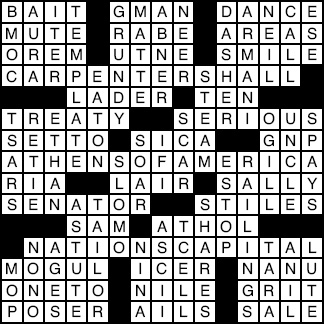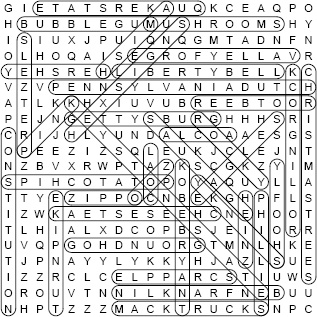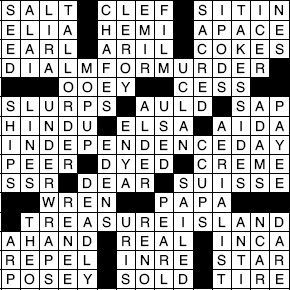Uncle John's Bathroom Reader Plunges into Pennsylvania (39 page)
Read Uncle John's Bathroom Reader Plunges into Pennsylvania Online
Authors: Bathroom Readers' Institute

8.
Fact.
From 1885 to 1915, the Liberty Bell traveled by train to world's fairs across the United States. In 1902, it was involved in an accident when the locomotive transporting it to an exposition in South Carolina collided with another train. The bell's last tour was in 1915, when it traveled to San Francisco for the Panama-Pacific International Exposition.
9.
Legend.
Philadelphia reporters noted that the “old bell” tolled on April 7, 1841, when President William Henry Harrison died, and there was no mention of a crack. However, an article published in 1848 in Philadelphia's newspaper the
Public Ledger
mentioned that the bell had cracked in 1845. Whenever it occurred, a hairline crack was repaired so the bell would hold together and ring on George Washington's birthday on February 22, 1846. But as the
Ledger
reported, “It gave out clear notes and loud . . . until noon, when it received a sort of compound facture in a zig-zag direction through one of its sides, which put it completely out of tune.” The bell had cracked up to the crown, and it hasn't been rung since.
10.
Legend . . . and hoax.
On April 1, 1996, Taco Bell ran a full-page ad in the
New York Times
announcing that it had purchased the Liberty Bell to help reduce the national debt and was renaming it the “Taco Liberty Bell.” It was just an April Fool's joke, but it backfiredâmany customers were offended.
page 114
The Pittsburgh Pirates Quiz,
page 169
1.
C. The team that eventually became the Pirates started playing in the American Association, an early pro league, in 1882. Other teams in that league that became current major league teams were the Cincinnati Red Stockings (the Reds), the St. Louis Brown Stockings (Cardinals), and the Brooklyn Atlantics (Dodgers). In 1887, the Pittsburgh team became part of the National League. Its first NL game: a win against the Chicago White Stockings (now the Cubs) by a score of 6â2.
2.
A. The team originally played in Allegheny City, across the Allegheny River from Pittsburgh. But when it joined the National League, the name changed to the Pittsburgh Alleghenies, even
though technically games were still played in Allegheny City. (The other names listed are from American Association teams in Brooklyn, Cleveland, and Cincinnati, respectively.)
3.
D. The team played in Allegheny City until 1908. In December 1907, Pittsburgh annexed the area, so when the 1908 season rolled around, the team finally got to play in the city of Pittsburgh even though it was playing on the same field as the year before.
4.
B. The team took the name Pirates in 1891 after “stealing” second baseman Lou Bierbauer from the Philadelphia Athletics. (The Athletics left Bierbauer off their reserve list, but assumed he'd stay with the team. He didn't.) The Athletics complained mightily, calling the signing “piratical.” The Pittsburgh team, amused by the outrage, decided to become the Pirates. The name finally made it onto the team jerseys in 1912.
5.
B. In 1890, the then-Alleghenies lost many of their players to the competing Pittsburgh Burghers. This weakened the team and led to a 23â113 season. The disastrous showing put the team's owner, Dennis McKnight, in the hole financially, and he had to sell the team. But McKnight had a plan: he bought a stake in the Burghers and then bought the Alleghenies again. That allowed him to merge the two teams (and the lost players) into one strong team.
6.
B or D
. . .
depending on how technical you want to get. The Pirates won the NL pennant in 1901 and 1902, before the World Series existed. Since there's been a World Series, the Pirates have failed to win it only twice after winning the pennant: in 1903 (the very first World Series, which they lost to Boston) and again in 1927 (swept by the Yankees). They notched World Series wins in 1909, 1925, 1960, 1971, and 1979.
page 180
Oh, the Symbolism,
page 211
1.
A. White-tailed deer live all over the United States except in the Southwest, Hawaii, and Alaska.
2.
B. Pennsylvania's top milk-producing county is Lancaster.
3.
B. Because it lives in cold-weather areas, the ruffed grouse has adapted to survive. In the winter, the birds grow projections off of their toes that act like snowshoes, and they can even spend the night burrowed under soft snow to keep warm.
4.
C. Tylerville fisherman Vonada Ranck holds the record for catching the largest brook trout in state history: it was 22 inches long and weighed 7 pounds.
5.
B. Rumor has it that Governor Pinchot actually preferred the
azalea to the mountain laurel and was going to make that the state's flower. But he deferred to his wife, who loved mountain laurels.
6.
A. Trilobites went extinct about 250 million years ago.
7.
C. There are about 2,000 species of fireflies in the world; they live mostly in warm, humid areas.
8.
A. Eddie Khoury and Ronnie Bonner wrote the song's music and lyrics.
9.
C. The K4s was the Pennsylvania Railroad's main passenger train between 1914 and 1957. At one time, the “Pennsy” had 425 of these engines in its fleet, but only two are still around today. One is at the Railroad Museum of Pennsylvania in Strasburg. The other used to be on display in Altoona, but suffered so much wear and tear from years outside that's it's being restored.
10.
B. Eastern hemlocks can grow to more than 100 feet high and live for 800 years.
page 225
1.
A or C. Bravo if you eliminated Quakers and Moravians right awayâthey don't wear old-fashioned clothes. As for the other two, take another look at the clothes. Color doesn't matter, but patterns do. Are the dresses striped, checked, flowered, plaid, or plain? The Amish wear only solid colors, so anything else suggests the girls are Mennonites.
2.
D. Amish communities do not have churches. Instead, they hold Sunday services in different homes each week, so a wagonload of benches is delivered to the designated house. Most Amish homes have dark green window shades. Why the plain, identical window treatments? The Amish community would consider
decorative shades or frilly curtains signs of vanity.
3.
B. Although a basket of buns and mugs of coffee may be passed around, the Moravian Love Feast is actually a festival that includes the singing of hymns and the playing of devotional music. The practice imitates the “agape” gatherings of the earliest Christians, celebrations held in the morning that included prayer and sharing a meal. Moravian Love Feasts can be held on holidays, anniversaries, or anytime church leaders decide that a little fellowship would bring spiritual blessings to the congregation.
4.
B. Although you might see foot washing at a pre-Easter service in a Catholic church, the Amish hold the only ceremony in which everyone gets their feet cleaned. Since the Amish religion was founded in Germany in the 1600s, congregations have held a special adults-only communion service (called Grossgemee) in the spring and fall. The service lasts all day, and the adults wash each other's feetâmen wash men's feet, women wash women'sâto imitate Jesus, who once washed the feet of his disciples.
5.
Most likely, the Quaker.
That's the only sect of the four that originated in England, and the British are great tea drinkers. If you said, “None of them would go into a bar!” you may be right. None of these groups approve of drunkenness or partying, but all of them actually do allow moderate drinking. Amish men enjoy beer, and the others have changed their attitudes toward drinking over time. Mennonites in the United States were completely against alcohol during the 19th and early 20th centuries, for instance, but the sect has since relaxed that stance. Today, about 60 percent of Mennonites consider moderate alcohol consumption to be acceptable.
page 256
1.
All of the above . . .
which is to say that each date has a claim to being the “real” founding date. Penn itself puts the date at 1740, when the colony granted a charter to a charity school for poor children on the property. However, it wasn't until 1749 that the school's trustees first convened. The first classes weren't held until 1751, and the actual college didn't get a charter until 1755.
2.
D. Benjamin Franklin wanted to start a “Publick Academy of Philadelphia” that taught both the arts and practical skills, rather than the religious subjects that the other colonial universities (Harvard, Yale, Princeton, and William & Mary) focused on. So in 1749, he bought an unused property and merged it with the state's charity school, establishing the college as an institution of higher learning. (Franklin wasn't the only Founding Father to found a Pennsylvania college. Benjamin Rush started Dickinson College in 1783.)
3.
B.
Leges sine moribus vanae means
“Laws without morals are useless”; the motto was officially adopted in 1932. It's attributed to William Smith, the university's first provostâwho nicked it from the Roman poet Horace. (The other mottoes listed here are for Dartmouth, Princeton, and Brown, respectively.)
4.
D. The Ivy League is composed of eight elite Eastern universities (Penn, Harvard, Yale, Princeton, Dartmouth, Brown, Cornell, and Columbia), but it specifically refers to a sports league made up of those schools. Sports rivalries among Ivy League schools date back to 1852 (when crew teams from Harvard and Yale squared off), and there was an Ivy Group football agreement in 1945. But it wasn't until 1954 that the Ivy
Leagueâthe NCAA Division I athletic conference that exists todayâwas formally created. And 1956â57 was the first academic year that the schools officially played in league sporting events.
5.
C. William Henry Harrison studied medicine at Penn, but didn't like the subject and left the school in 1791. He did all right anyway, becoming a war hero, general, congressman, governor, and ambassador before winning the presidency in 1840. His best-known act as president: dying after just 30 days in office. He caught pneumonia after giving an hours-long inauguration speech in the rain.
6.
B. The ENIAC (short for “Electronic Numerical Integrator and Computer”) was the first general-purpose electronic computer. Physicist John Mauchly and engineer J. Presper Eckert Jr. began work on it in 1943 at Penn's Moore School of Electrical Engineering. They designed the computer primarily to compute values for artillery tables, which would help make World War II artillery attacks more accurate, but the computer wasn't finished until 1946, so its original purpose was virtually obsolete. Instead, scientists used ENIAC to compute figures for creating a hydrogen bomb.
ENIAC cost $400,000 to build and had 18,000 vacuum tubes, 70,000 resistors, 10,000 capacitors, 6,000 switches, and 1,500 relays . . . all stuffed into a room that measured 30 Ã 50 feet. An urban legend says that when the engineers at Penn turned ENIAC on, all the lights in Philadelphia dimmed. Eckert denied that in 1989, saying, “That story is total fiction, dreamed up by some journalist.”
page 266



